There are several ways that a person can tune a guitar. For me personally, I like to use either a Boss TU-3 pedal, a Snark clip-on tuner, or Blue Cat Audio’s Hot Tuna. Just right there, that is 3 different ways of tuning your guitar: one is a clip-on tuner, one is a software tuner, and the other is a hardware/guitar pedal tuner.
But how would you go about tuning your guitar if you don’t own any of these things, but you do, on the other hand, own a piano or a keyboard of some kind? It’s possible that you may even just have a MIDI keyboard connected to a DAW and you want to tune with that. How would you go about doing it?
To tune the guitar with a piano, find the notes, E, A, D, G, B, and E on the piano and then strike each piano key individually while matching the pitch with your guitar strings. Do one string at a time, starting from either the low e-string (E2) or high e-string (E3).
One of the cool things about tuning your guitar with the piano is that I find it’s nice to get your instrument into an altered tuning. A popular tuning for acoustic guitars, for example, is DADGAD (a Dsus4 chord), and using a keyboard/piano just might be easier if you want to do it quickly.
One reason using a piano for altered tunings is easier is that not every tuner is fully capable of stretching from note to note super quickly in the same way that a piano can. Your only limitation when using a piano as a tuner is your skill level and knowledge of the keys, but I digress. Let’s walk through how to do this.
Tools You Need to Tune a Guitar with the Piano
1) Keyboard, MIDI Keyboard, or Piano
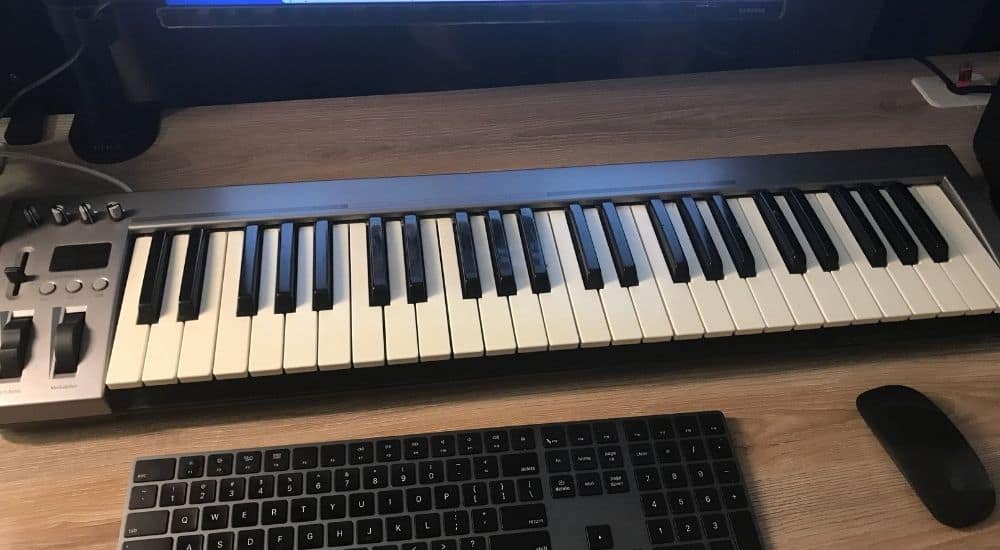
You don’t need a full grand piano to tune a guitar, although, there’s certainly nothing wrong with doing so if you have one. Using a regular piano, assuming it has been tuned recently, is a solid way of tuning your guitars and other instruments, if for whatever reason, you don’t have access to a tuner.
Nearly all instruments are notated in the same way, which is one reason why all notes and chords can be applied to piano and guitar with some exceptions (my article on this).
Because I don’t have a grand piano in my apartment, I’ll be using a MIDI keyboard connected to Garageband to tune my instrument.
If you plan on using a regular piano, you don’t even need Garageband or any DAW, you just need the piano itself.
2) Guitar
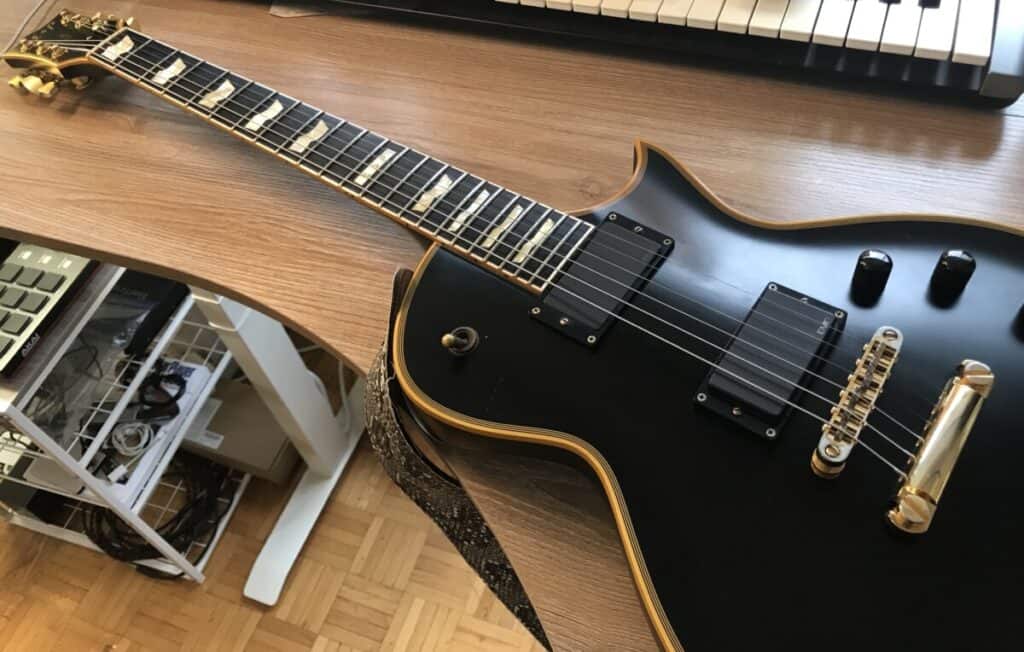
Obviously, you need a guitar to tune one. I’ll be using my ESP Eclipse for this tutorial as a way of demonstrating how to go about this. This is an excellent guitar and I wholeheartedly support getting one.
Optional Tools
3) A DAW like Garageband (If You Don’t Own A Keyboard or Piano)
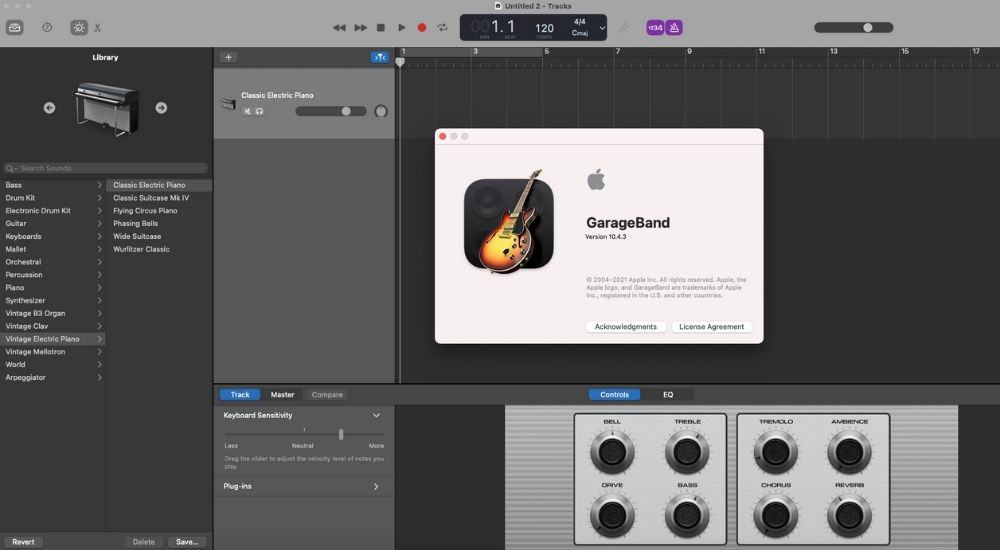
As I said earlier, I’ll need to use Garageband in order to load up a piano for tuning. Garageband actually already has a default tuner but as I’ve explained before on my other site, Producer Society, it’s not the best.
Ironically, you’d be better off using the VST pianos to tune your instrument than the tuner that Garageband gives you.
Blue Cat Audio has a great tuner called Hot Tuna that works well. It includes the awesome amplifier simulator, Axiom, and the distortion plugin, Destructor, in addition to some other cool effects.
How to Tune A Guitar with the Piano
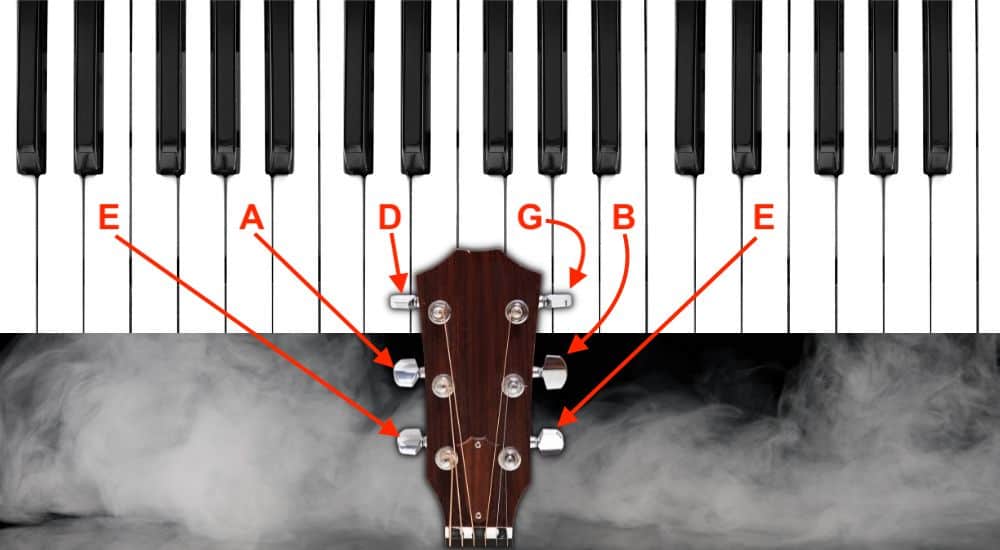
The middle C, as we’ll explain in a second, is the purple ‘C that I’ve outlined in the image shown above. This ‘C’ on the MIDI keyboard is the 1st fret C on the B-string of the guitar.
The 1st fret C on the B-string is C4 on the regular piano, but C3 on the MIDI keyboard. At least C3 is middle C in Garageband and on my 49-key keyboard.
1) Sit Down With Your Guitar by the Piano
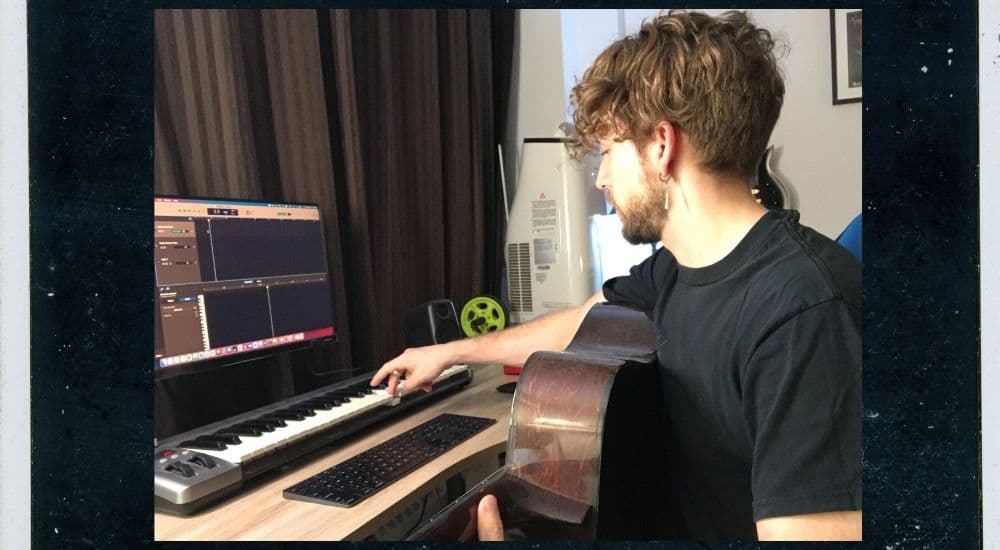
With your guitar in hand and your piano (or DAW with your MIDI keyboard) in front of you, sit down and get comfortable because it’s going to take a moment to tune your guitar.
If you’re using a DAW like Garageband, it wouldn’t hurt to turn the volume way up on your speakers that way you can actually hear what’s going on. You could also do it by turning up the master volume in Garageband.
2) Hit the E, A, D, G, B and E keys Within the Middle C Octave
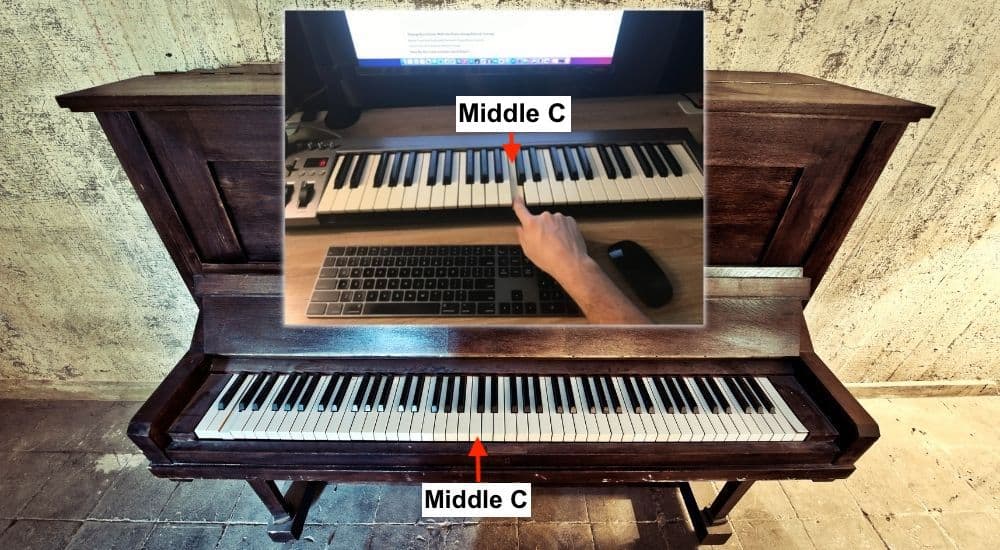
From what I understand, C3 on a MIDI keyboard is middle C, however, on a regular piano, middle C is actually the 4th C from the left side of the piano. You can see what this looks like in the image that’s shown above, so this is something that you should keep in mind.
Put simply, if you’re using a MIDI keyboard and a DAW like Garageband, you want to use C3 as the reference point by which you tune your guitar, and if you’re using a real-life piano, you want to use C4, or the 4th C from the start of the piano on the left-hand side.
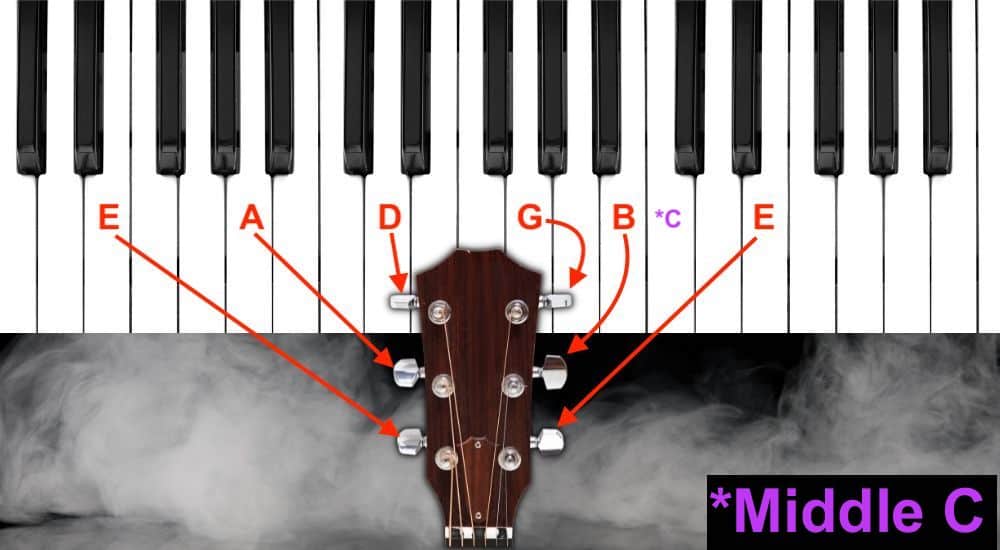
As I briefly mentioned earlier, one way that’s very useful for understanding where you are on the piano relative to the guitar is to think of Middle C as the 1st fret on the B-string.
Explained another way, C on the 1st fret of the B-string is the Middle C on the piano. It’s the C3 on the MIDI keyboard and the C4 on the regular piano. You can see what that looks like in the image below.
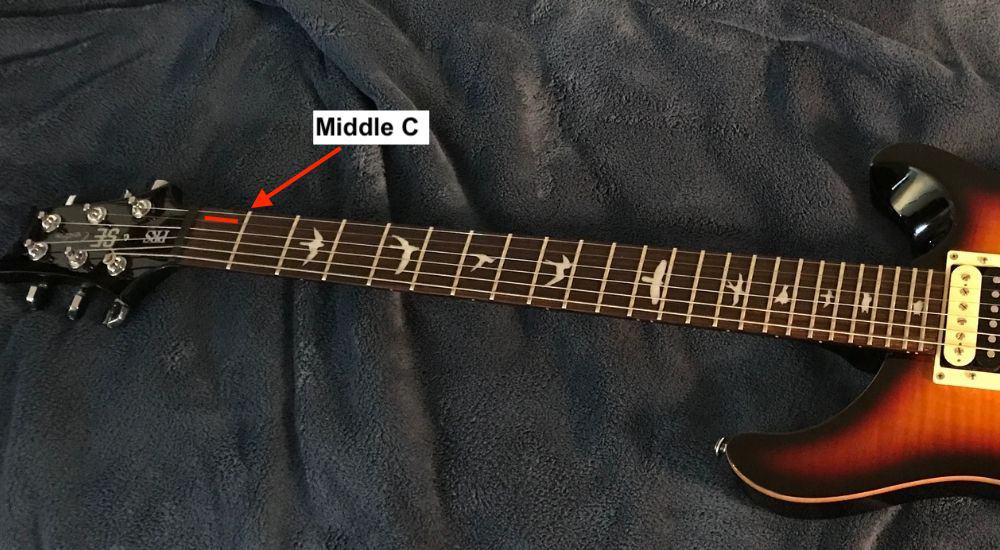
3) Use Your Ear to Match The Notes Up With the Piano
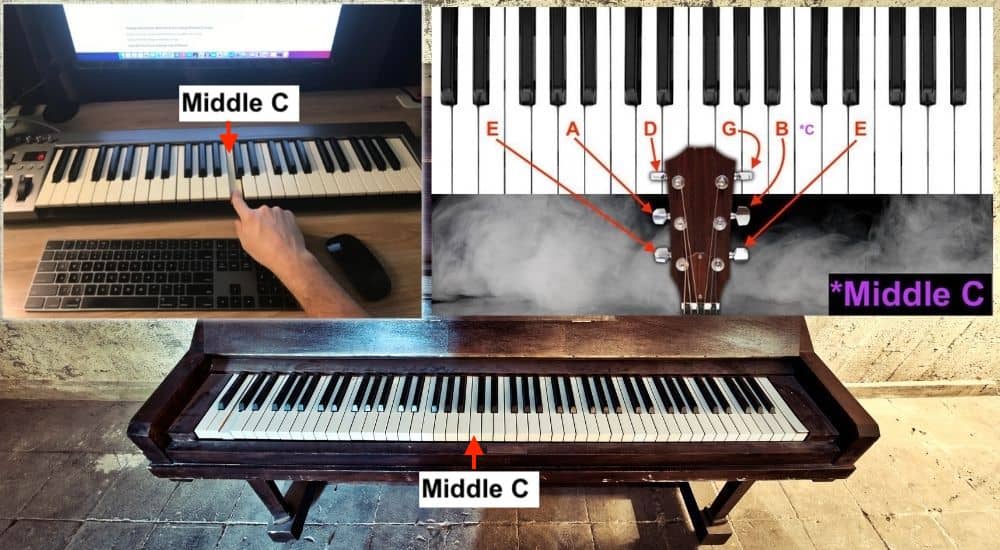
To tune your guitar with a piano, you just have to use the diagram shown above as a frame of reference. It’s important to use the actual keys that I’ve outlined here, because they’re listed in a particular order and octave, and you want their pitch to be relative to each other in the correct way.
What I mean by that, is that you wouldn’t want to use the higher E on the right-hand side of the image as the E for the low-E string and then work backwards from there.
That wouldn’t make any sense but I digress. For this part, you just have to listen carefully to tune the guitar up to the notes of the piano.
If you’re tuning a guitar with the fretted note of another string, there is a way that the strings vibrate together which indicates that it’s in tune.
It’s as if the two notes are in total harmony with one another, and there is no dissonance. Explained in another way, it’s like the note has just been doubled and thickened up.
Unfortunately, there isn’t really a special trick that I know of to make it super easy to tune along to a piano, but I do have three tips for you so you’re more equipped to use the piano method.
Use the Piano Roll to Copy and Paste the Notes You Need
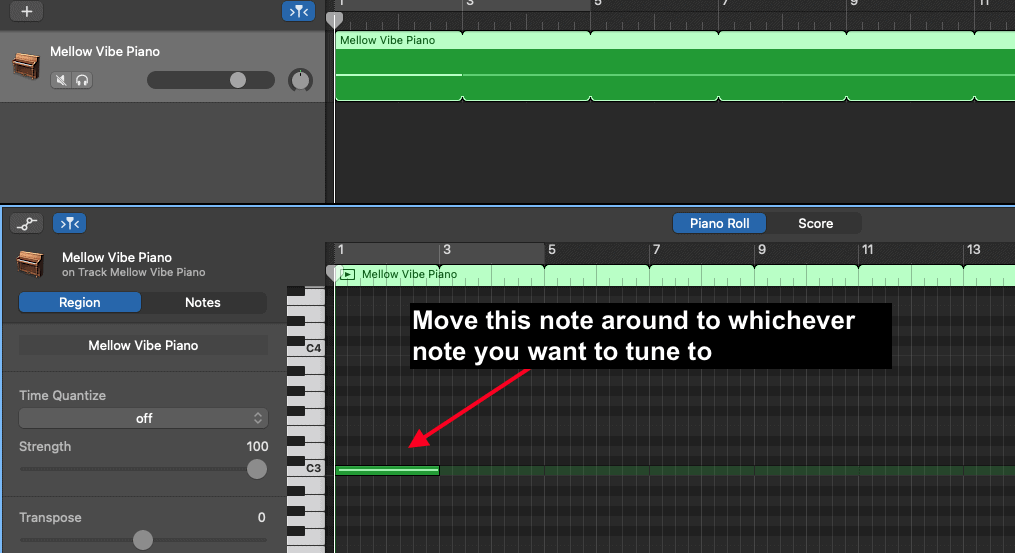
I find it’s actually easier to use the piano roll to copy and paste the note on every single beat, that way you don’t have to continue striking the note every time you want to hear it for tuning purposes. Frankly, this is the primary downside of tuning with a piano, and not a MIDI keyboard and a DAW.
You can just copy and paste the note across the piano roll, loop it, turn the volume up on your speakers, and you now have a reference track by which to tune your guitar.
Tune Up To the Piano Note And Not Down To It
A good rule of thumb for tuning an instrument is that it’s best to tune up rather than down to a target note. It’s just way easier to tune a stringed instrument this way, and this applies to many other stringed instruments as well, not just guitars.
Do your best to tune it perfectly up the first time you turn the knob. You can tune the guitar down again and then back up to refresh your ear, so to speak, which allows you to hear what it sounds like again with a renewed sense of what is the proper pitch.
Some of the Most Popular Altered Tunings
I made this octave chart which designates which octave each note is on the piano roll. I said earlier that Middle C on the MIDI keyboard was C3, which is also the 1st fret C on the B string. This chart should help you tune your guitar to some of the most common tunings.
Guitar Tuning | Notes | Piano Roll Notes and Octave (MIDI) |
| Standard | E-A-D-G-B-E | E1, A1, D2, G2, B2, E3 |
| Drop D | D-A-D-G-B-E | D1, A1, D2, G2, B2, E3 |
| DADGAD | D-A-D-G-A-D | D1, A1, D2, G2, A2, D3 |
| Drop C | C-G-C-F-A-D | C1, G1, C2, F2, A2, D3 |
| Open C Tuning | C-G-C-G-C-E | C1, G1, C2, G2, C3, E3 |
| D Standard | D-G-C-F-A-D | D1, G1, C2, F2, A2, D3 |
| Open D Tuning | D-A-D-F#-A-D | D1, A1, D2, F#2, A2, D3 |
| Open G Tuning | D-G-D-G-B-D | D1, G1, D2, G2, B2, D3 |
| Drop B Tuning | B-Gb-B-E-Ab-Db | B0, F#1, B1, E2, G#2, C#3 |
Using the Piano to Tune Your Guitar to Altered Tunings
1) Standard Tuning

I already showed you how to tune the guitar to standard tuning, but here it is again. You also want to ensure that you’ve chosen the octave range between E1 and E3 if you want to be in standard tuning, but I’ve talked already about getting that right a few times now.
2) Drop D
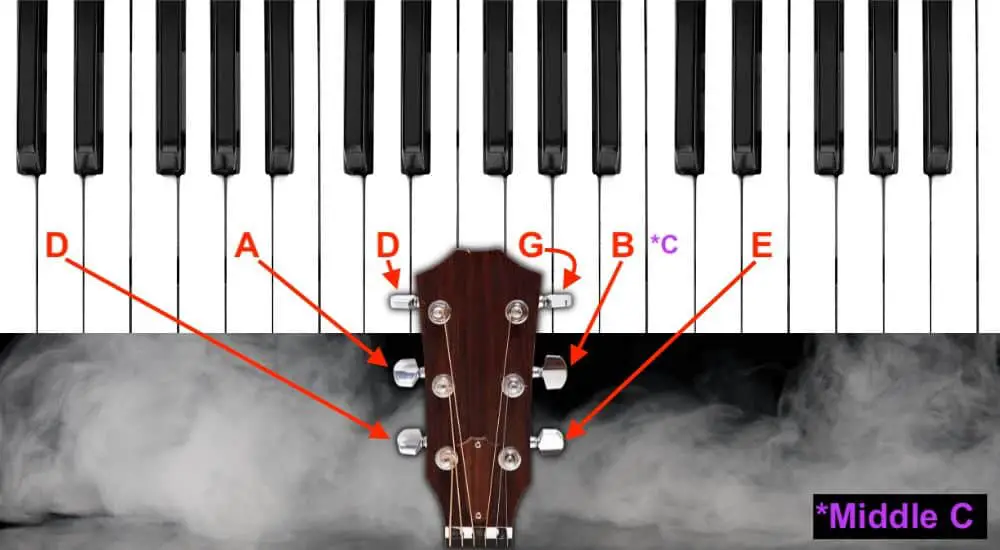
Tuning your guitar to Drop D tuning isn’t a whole lot different than standard E tuning. The only difference is that you tune the bottom E string to D.
This is probably the tuning of the 1990s Seattle rock movement, with most bands, including Nirvana, Alice in Chains, Pearl Jam, and Soundgarden, composing quite a few songs with it.
Soundgarden was definitely the more experimental of the group, that’s for sure, both in terms of tunings and time signatures.
3) DADGAD
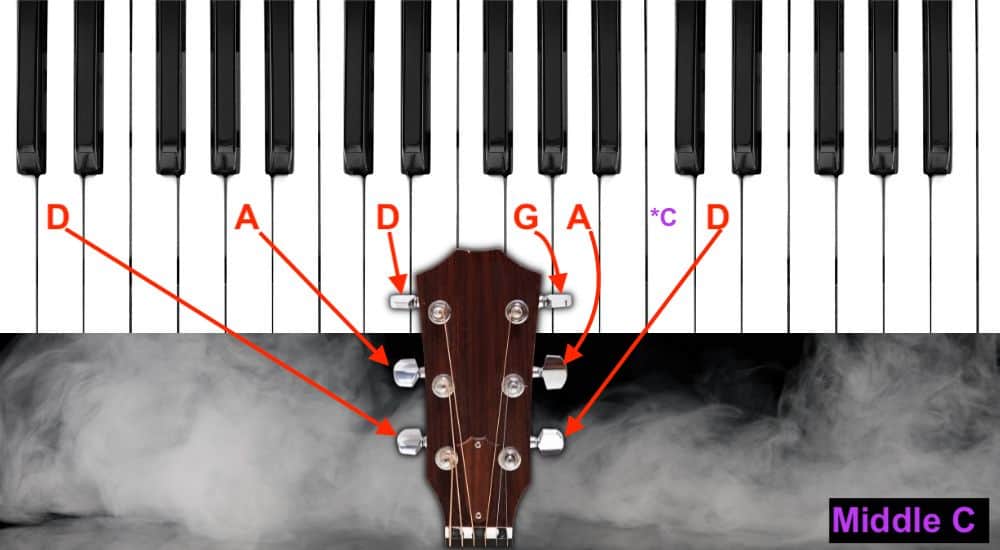
DADGAD – which is pronounced just the way that it look – according to Wikipedia, is a celtic tuning that is used in that very same style of music.
From what I can tell, DADGAD is a Dsus4, which is short-form for D Suspended 4th, which is just a D Major chord but with a fourth added to it counting up from the D, which is a G.
A regular D Major chord is D-F#-A, but the Dsus4 chord is D, G, A. By removing the major 3rd which is the F#, but adding the 4th, you remove the major tonality of the chord and it becomes more tonally ambiguous in the sense that it’s neither minor nor major.
D to G is a perfect 4th interval, which is neither minor nor major. Get Mark Sarnecki’s music theory elements books from Amazon including the Answer Book if you want to learn all of this very basic music theory.
4) Drop C
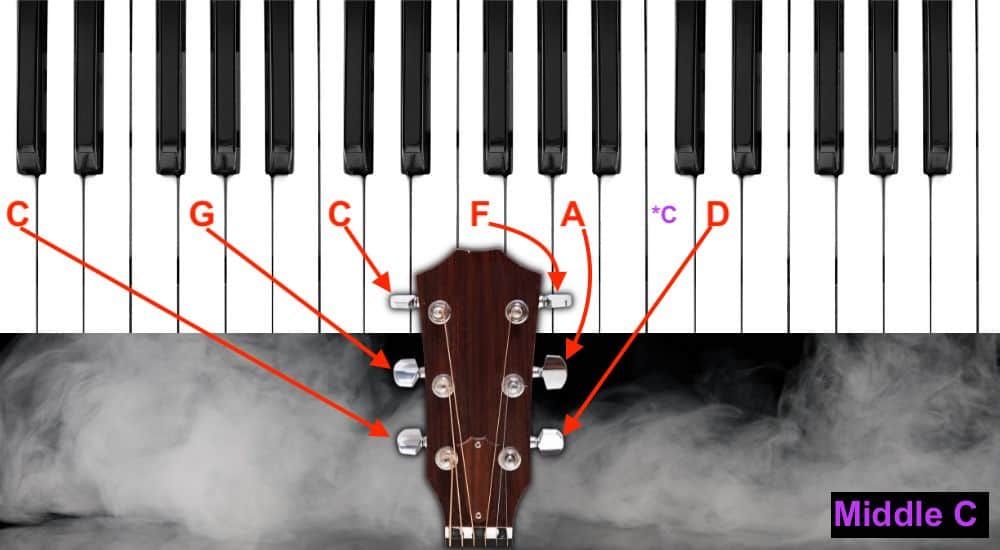
Drop C tuning is D standard but with the low D dropped down to C1. This is the key signature commonly used in metal songs and hard rock, for sure.
Before the popularity explosion of 7-string and 8-string guitars, people most commonly used Drop C when they wanted to sound heavy.
From what I can tell, this was a tuning very commonly used in the metal scene from the early 2000s up until the start of the 2010s.
These days, though, you’re more likely to see Drop B on a guitar with more than 6 strings. That isn’t to say that people still don’t use this tuning, however.
5) Open C
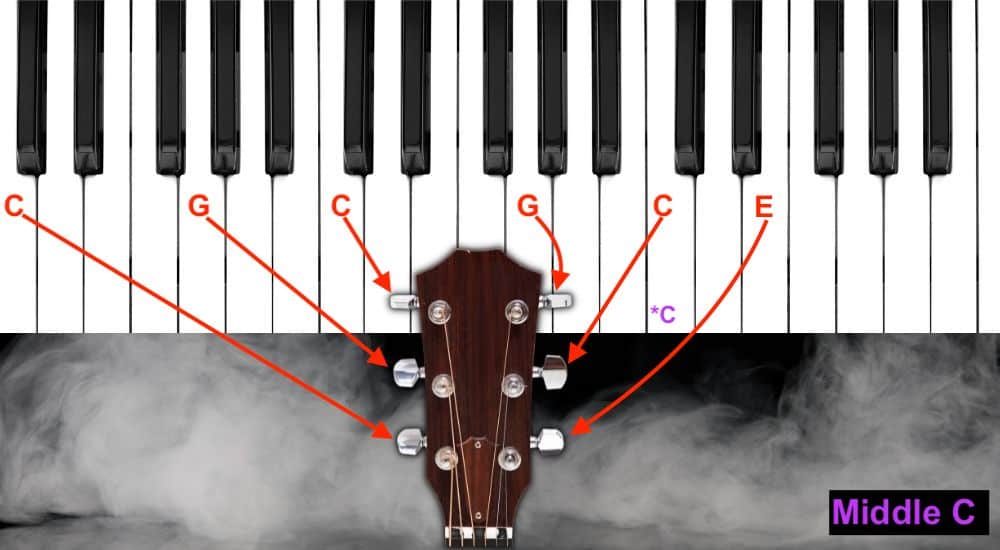
Open C tuning is just the guitar tuned up to the notes of a C Major chord, ie, C-E-G. The three notes of the C Major triad comprise the entire tuning, except the three C notes are at 3 different octaves, including C1, C2, and Middle C.
Other than using it to make this article, I’ve rarely used this tuning before.
It’s worth mentioning though that I probably should use altered tunings more often because they’re awesome to compose with, especially if you’re trying to get a particular modal tonality.
In other words, if you tune your guitar to the notes of a G Major 7th chord, but you add a C# in there which is a #4, you get a Lydian sound.
6) D Standard
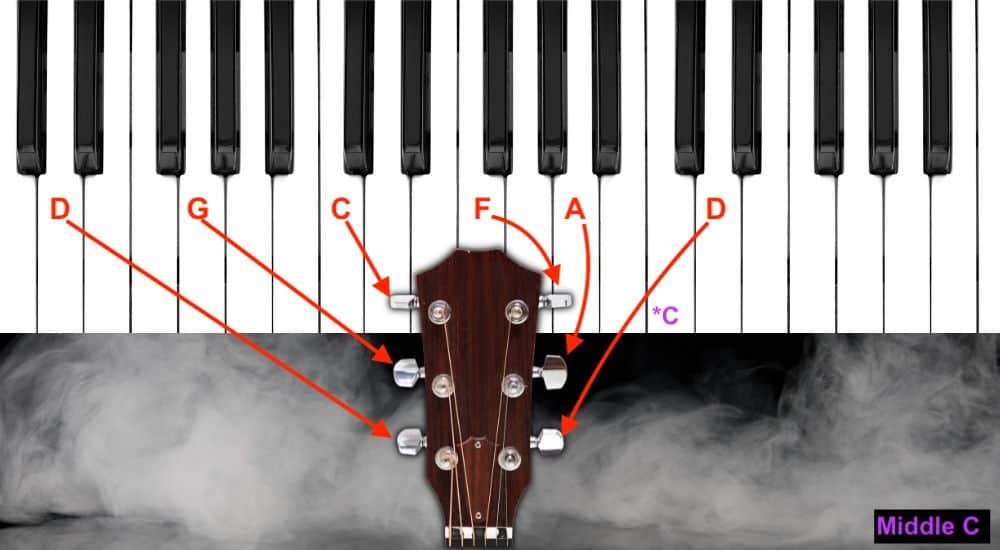
D Standard is just E standard but with everything dropped down one whole step. I like having at least one guitar tuned down to D standard. I’m not sure why, I just find that this is a nice tuning to play a guitar in, and it’s also nice to have a guitar that’s capable of playing Drop C.
7) Open D Tuning
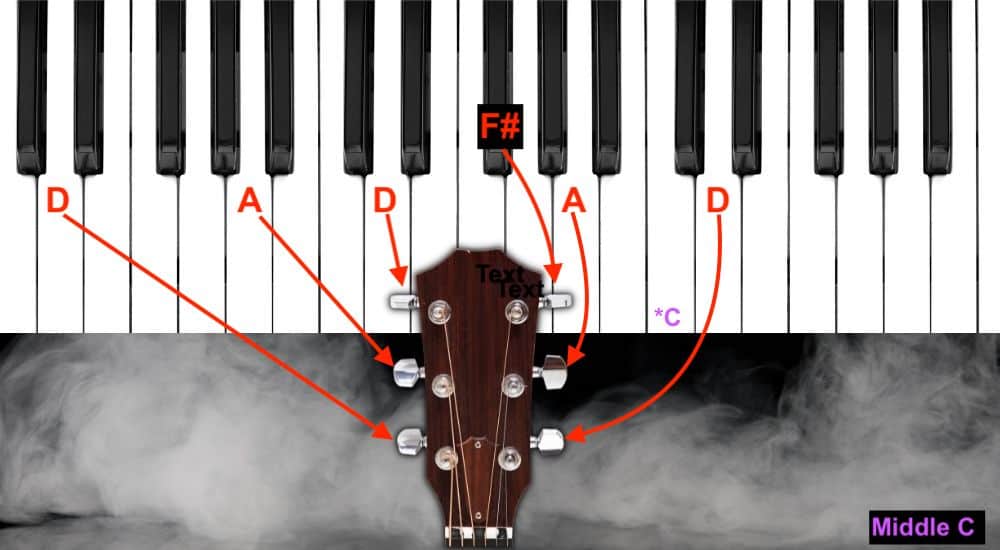
Open D tuning is just the notes of the D Major chord, D-F#-A, and with 3 Ds at 3 different octaves, D1, D2, and D3.
Alternative tunings are really interesting to experiment with because you can alter them slightly to make extended chords or 7th chords which I’ve talked about before in my guide on how to find the key of any song on guitar.
For instance, adding to what I mentioned earlier about modal tonalities if you just change that D3 on the high E string to C# instead, you have a D Major 7th chord, and it sounds super cool. I recommend giving that a shot.
8) Open G Tuning
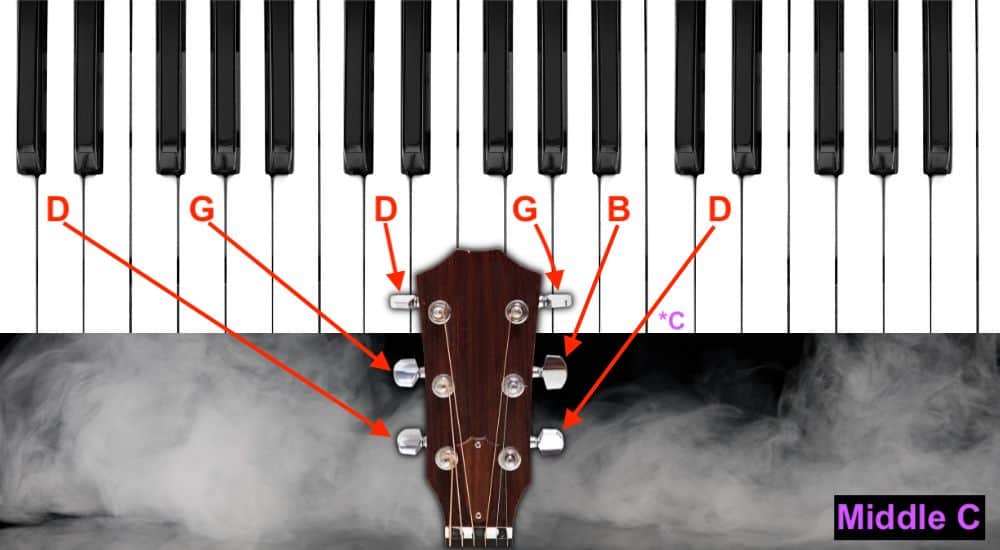
Open G tuning is the notes of the G Major chord but with the D (which is the 5th) in the bass. In other words, it’s more like a D/G Major chord, but it’s still the G major, even though it has 3 D notes in it. I’ve never used this tuning either, other than to make this tutorial.
9) Drop B Tuning
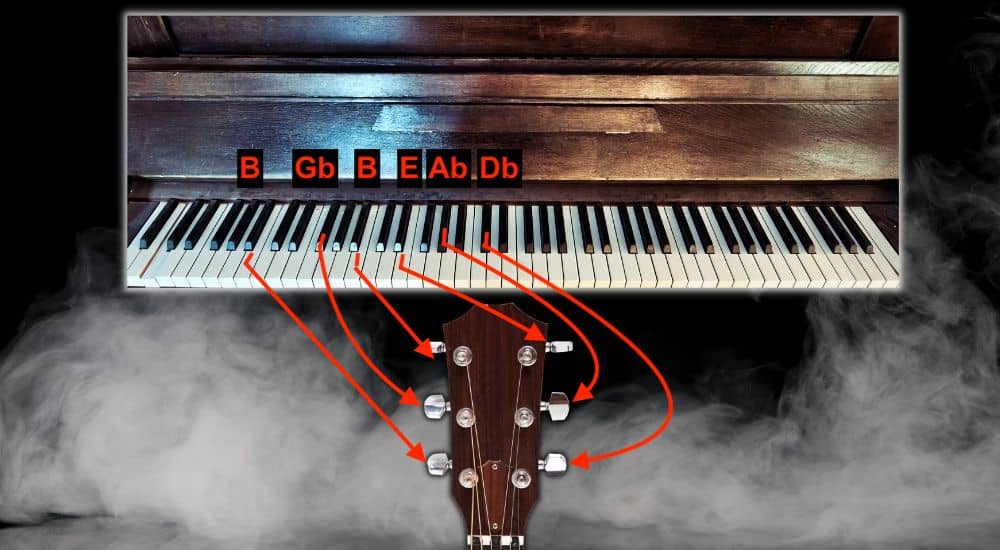
Drop B tuning, like Drop C tuning, is just standard tuning dropped down several tones and then the low E dropped down another one to make creating power chords much easier. I had to actually use a different picture of a piano because my MIDI keyboard doesn’t go down to B0 unless I adjust the octave.
Drop B tuning is C Standard, all notes are dropped down by two notes, and then with the bottom B tuned down another full note. I’d say you’re more likely to see this on a 7-string or similar guitar because it’s quite low.
One thought I had lately is what it would sound like to play Bossa Nova rhythms in Drop B tuning? Just a thought.
How Do You Tune a Guitar Like A Piano?
To tune a guitar like a piano, you would have to tune the strings to unusual increments and notes that aren’t associated with any kind of commonly used tuning. For example, if you were to tune the 6 strings according to the piano, the notes would be C, C#, D, Eb, E F.
On the other hand, how you tune a guitar like the piano depends on what notes of the piano you’re using. You could also use the notes of the C Major 7 chord from the piano to make the notes of a guitar tuning, ie, C-E-C-G-B-E. C, E, G, and B are the notes of the C Major 7th chord.
Is ‘Middle C’ C3 or C4?
Middle C in a DAW like Garageband, for example, is usually C3, however, on a regular piano it’s C4. Additionally, MIDI keyboards that are 88 keys like Arturia’s KeyLab that I mentioned earlier also have their C4 as the Middle C.
Important Things to Mention About Tuning Your Guitar With A Piano
1) If You Have A DAW, You Have Access to a Tuner
The elephant in the room here is that if you have access to a DAW whether it’s Garageband, FL Studio, Pro Tools, Logic Pro, or Cubase, chances are your DAW has a built-in tuner or you can just download a free tuner from a website like Plugins4Free.
2) You Can Download Tuners on Your Phone
Furthermore, in the case that you just want to get your hands on a tuner in another way, you can simply download one on your phone.
I use an iPhone 14 because it has optimal storage space, which, as I’ve argued many times before, is incredibly important when creating music.
Fender has a tuner you can download, as does D’Addario and many other companies. The fact of the matter is that you don’t need a piano to tune a guitar anymore because we all have smartphones and plugins.
3) You Can Also Use Website Tuners
Tuners are available on websites like Get-Tuned as well so you don’t even have to use an application if you don’t want to. These websites are easily accessible on your phone.

 Written By :
Written By :